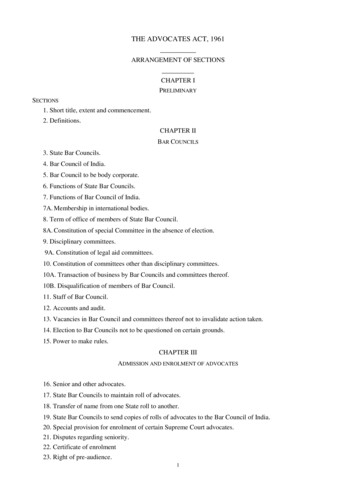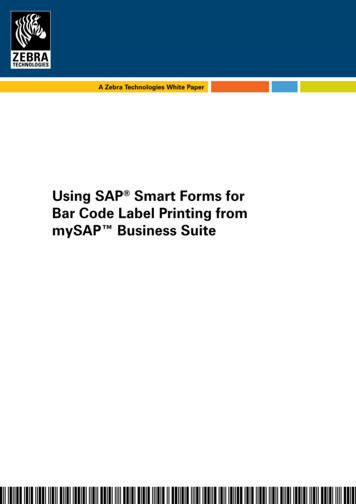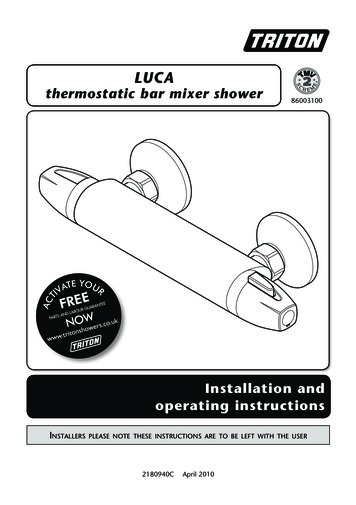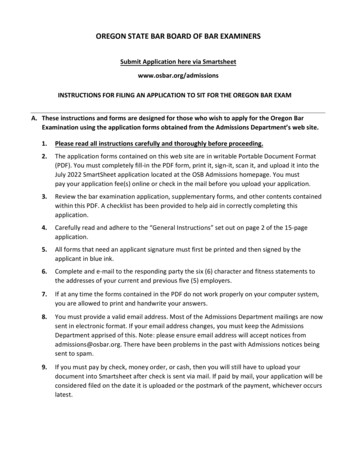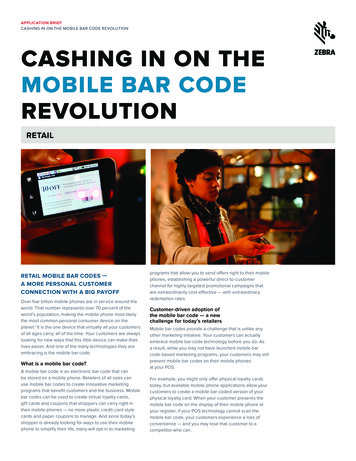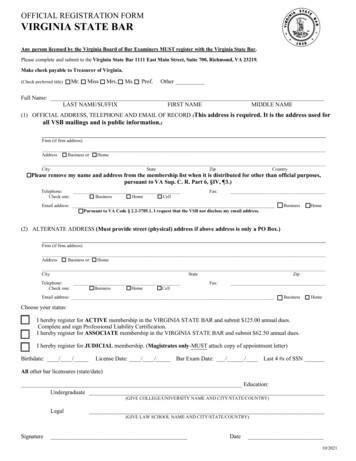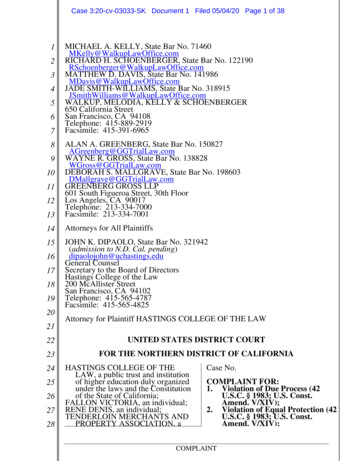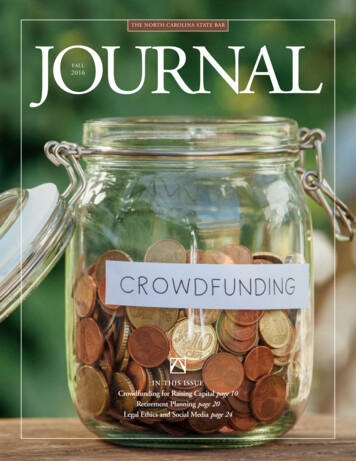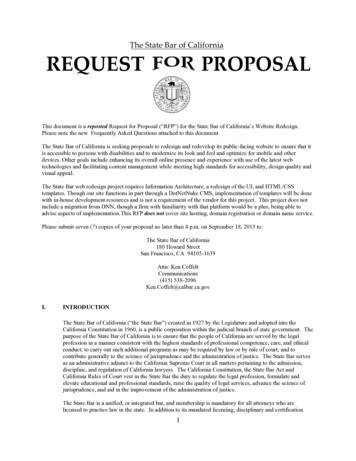
Transcription
This document is a reposted Request for Proposal (“RFP”) for the State Bar of California’s Website Redesign.Please note the new Frequently Asked Questions attached to this document.The State Bar of California is seeking proposals to redesign and redevelop its public-facing website to ensure that itis accessible to persons with disabilities and to modernize its look and feel and optimize for mobile and otherdevices. Other goals include enhancing its overall online presence and experience with use of the latest webtechnologies and facilitating content management while meeting high standards for accessibility, design quality andvisual appeal.The State Bar web redesign project requires Information Architecture, a redesign of the UI, and HTML/CSStemplates. Though our site functions in part through a DotNetNuke CMS, implementation of templates will be donewith in-house development resources and is not a requirement of the vendor for this project. This project does notinclude a migration from DNN, though a firm with familiarity with that platform would be a plus, being able toadvise aspects of implementation.This RFP does not cover site hosting, domain registration or domain name service.Please submit seven (7) copies of your proposal no later than 4 p.m. on September 18, 2015 to:The State Bar of California180 Howard StreetSan Francisco, CA 94105-1639Attn: Ken CoffeltCommunications(415) 538-2096Ken.Coffelt@calbar.ca.govI.INTRODUCTIONThe State Bar of California (“the State Bar”) created in 1927 by the Legislature and adopted into theCalifornia Constitution in 1960, is a public corporation within the judicial branch of state government. Thepurpose of the State Bar of California is to ensure that the people of California are served by the legalprofession in a manner consistent with the highest standards of professional competence, care, and ethicalconduct; to carry out such additional programs as may be required by law or by rule of court; and tocontribute generally to the science of jurisprudence and the administration of justice. The State Bar servesas an administrative adjunct to the California Supreme Court in all matters pertaining to the admission,discipline, and regulation of California lawyers. The California Constitution, the State Bar Act andCalifornia Rules of Court vest in the State Bar the duty to regulate the legal profession, formulate andelevate educational and professional standards, raise the quality of legal services, advance the science ofjurisprudence, and aid in the improvement of the administration of justice.The State Bar is a unified, or integrated bar, and membership is mandatory for all attorneys who arelicensed to practice law in the state. In addition to its mandated licensing, disciplinary and certification1
functions, the State Bar offers a number of other programs designed to assist, educate and protect itsmembers and the public. Fees paid by attorneys and applicants to practice law finance the State Bar’sprograms. The State Bar has over 253,000 members, making it the largest unified state bar in the countrywith offices located in Los Angeles and San Francisco. For more than 80 years, The State Bar of Californiahas shaped the development of the law, regulated the professional conduct of the state’s lawyers andprovided greater access to the justice system for all citizens. More information about the organization canbe found at http://www.calbar.ca.gov/AboutUs.aspx.II.Statement of WorkA.BackgroundThe State Bar’s website was originally released in 2003 and has gone through several redesigns,culminating in the current website released in 2010. In 2010, the State Bar began requiring thatall documents placed on the State Bar’s websites be accessible to person with disabilities. In2012, the State Bar adopted a policy that required all electronic and information technology to beaccessible to persons with disabilities and for it to meet the World Wide Web Consortium’s(W3C) Web Content Accessibility Guidelines (WCAG), version 2.0. The current website designand content delivers large amounts of regulatory and archival information. While the website hasmet the needs of the Bar, it has not kept up with the latest standards that ensure that the website isaccessible to persons with disabilities and the latest technological advances that are important toour members and visitors making the site difficult to navigate and search, too many outdatedpages, and not designed for mobility and viewing on mobile devices.The redesign will facilitate content delivery – including facilitating views on mobile devices – thatsupport the bar’s web communication strategy for its users. The Bar serves three primary targetaudiences—Bar applicants, members, and the public. All of these constituencies contain personswith disabilities.1.Applicantsa. access information about the California Bar Examinations,b. obtain and submit applications and admission forms, andc. track their progress in the admissions process.2.Membersa. maintain their contact information on My State Bar Profile,b. pay fees,c. file mandatory reports,d. report completion of State Bar-mandated continuing legal education requirements,e. access information on and participate in areas of legal specialties through theSections & Education portals3.Public usersa. search for an attorneyb. find legal information in multiple languagesc. obtain attorney referral services,d. file complaints against attorneyse. locate attorney contact information and discipline historyf. obtain printable forms and materials (some in multiple languages)g. access public documents, such as agendas, public comments and reportsh. locate historical information regarding the State Bar and officials2
In addition, the website serves as a tool for the bar to disseminate information and news to the larger legalcommunity in the state, including judges, legislators and legal organizations. It is where the bar’s officialpublication, the California Bar Journal is published.B.Current EnvironmentThe current portal consists of 19 websites in a DotNetNuke (DNN) content management systemand will continue to use DNN CMS throughout this project.Website LayoutTitleAdmissions of The State Bar of CaliforniaAntitrustBusiness LawCalbar ConnectCalifornia Legal SpecialistsCalifornia Young Lawyers AssociationCommittees and CommissionsCriminal LawEnvironmental LawEthicsFamily LawSections of The State Bar of CaliforniaSolo and Small FirmTaxationThe California Bar JournalPortal .ca.govwww.calbarjournal.comThe State Bar Court of CaliforniaThe State Bar of CaliforniaTrusts and EstatesWorkers Page counts do not include linked documents like PDFs, MS Word Docs and images. There areapproximately 6,000 of those types of files amongst the sites. The site also hosts another 7,000 files at calbar.org. Some of those are linked in DNN.C.Technical Environment1.Web HostThe current website portal is hosted at the State of California’s Office of TechnologyServices (OTech) located in Sacramento, CA. Detailed information will be providedupon engagement with the selected Contractor.2.Programming Language and Applications3
The programming language used for web applications are written in C# .Net utilizing MSSQL and IBM DB2 databases. Detailed information will be provided upon engagementwith the selected Contractor.3.E-commerceLegacy e-commerce applications will continue to be used during and after the redesign.Most, if not all, functionality will remain the same, but will adopt new templates andstyles. The services use are USbank – ePayment and Authorize.Net4.Other technology utilized with the web site:a. Email marketing – Lyris ListServb. ASP Online event registration – XAP for Admissions, DWAlliance for Sections &Educationc. Video hosting – YouTube, but no formal on-premise systemd. Member Information Management – MyStateBarProfile in-house developed webapplicatione. Hummingbird/OpenText – Collaboration Portal only5.Website Statistics97% of State Bar traffic is US. No one country has more than .4% of other traffic (Canada,Philippines, UK, and India are the highest.) PC vs. Mobile device usage: 84% desktop/laptop, 12%mobile, 4% tablet. Types of browsers used to access the site are Chrome, IE, and Safari are themajor browsers with Firefox around 10% depending on the data sample. Windows is about 70% ofOS traffic with Mac and iOS making up about 20 %.6.Multi-Lingual SupportCurrently all web applications support only English. However the state bar website search featuressupports all languages and provides translation options on website. There are specific pages onCalbar.ca.gov in Spanish such ion/LegalInformationSP.aspx7.ADA ComplianceThe State Bar has voluntarily opted to begin following the World Wide Web Consortium’s (W3C)Web Content Accessibility Guidelines (WCAG) 2.0 due to its commitment to make the State Barwebsite accessible to person with disabilities. The State Bar has chosen to require compliancewith the WCAG 2.0, Level AA accessibility guidelines because the W3C is a long-standing,international collaborative with extensive expertise in the development of design protocols for theWorld Wide Web. When completed, the revised Section 508 standards of the Rehabilitation Actwill be primarily based upon WCAG 2.0, level AA. The State Bar requires completion of StateBar’s Accessibility Standards in Procurement and demonstrable proof that digital content iscreated with accessibility built into the development lifecycle.8.Website Goals & ObjectivesThe project objective is to create a website that is accessible to persons with disabilities that is alsoan aesthetically pleasing website with an intuitively accessible navigation scheme to serve as apublic communication tool; better support access from mobile devices; and provide adaptabilityfor changing web technology.a.Redesign the website to make the website accessible so that visitors with disabilities canperceive, understand, navigate, and interact with the State Bar’s website.4
b.Redesign the website with a new and consistent look and feel, including color schemesand graphic elements to unify the website based on collaboration with staff.c.Design must conform to a look & feel that works with mobile and tablet browsers usingresponsive website design. This is to provide an optimal viewing experience, easyreading and navigation with a minimum of resizing, panning, and scrolling across a widerange of devices.d.Improve the information architecture that supports easy navigation of the site to key StateBar services, encouraging visitors to return.e.Analyze and recommend improvements on how pages, documents and image librarieswill be organized, updated and maintained to handle future growth, including newcontent and/or additional sub-sites.f.Search Engine Optimization (SEO). Optimize search function for each portal.g.Expand the services the State Bar offers to members and visitors on the website.h.Enable updating the look and feel of the website on an as-needed basis.i.Update and implement website technology management policy and best practices thatmaximizes utility of web metrics.j.Identify and formalize content contributors from each department who will ensure that allcontent is accurate and up to date.k.Identify and formalize use of web social networking tools.l.Identify and formalize acceptable website content and links to outside resources.m. Provide for full integration with existing e-government applications currently in use andprovide for easy integration with future e-government applications. Electronic and Printdeliverables aligned with the site.n.III.Multi-Lingual SupportProject Scope / DeliverablesA.Discovery and AssessmentContractor will review State Bar’s website focusing on accessibility, content presentation,navigation structures, organizational architecture, content placement, etc. Communications(COM) and Information Technology (IT) staff will help Contractor to understand the variouscontent types used on the website and how each is displayed. In addition, COM/IT staff will helpthe Contractor understand the range of visitors to the Bar’s website in order to better understandthe target audiences and their constraints. Contractor will analyze and assess the website as itrelates to achieving project goals. Contractor will review and evaluate the results of existing webmetrics and statistics from reports generated by the web analytics tools and any surveys, customer5
service calls/emails, accessibility and usability results feedback to better understand how ourvisitors are accessing and interacting with our website.Deliverables1.A detailed evaluation methodology that describes the methods used.2.B.A detailed evaluation report for the Bar’s website including an assessment of the currentlevel of accessibility, current information architecture, a review of the user experience,and an analysis of available user feedback data (including web analytics data, email logs,surveys, etc.).Requirements GatheringContractor will work with the Project Team and/or key stakeholders to review the Website Goals& Objectives and conduct requirements gathering working sessions on-site to all key stakeholders.Communications team to disseminate to key stakeholders, internal departments, collect andcompile input on needs and goals, develop and describe strategy and goals for overall project.Communications team will keep internal teams apprised of project.Deliverables1.Requirements gathering working session with all key stakeholders.2.C.Website Redesign Requirements document for customer agreement and signed-offrequirements.Concept and DesignBased on the review and evaluation conducted in the Website Discovery and Assessment andRequirements Gathering sessions, Contractor will develop a Proof-of-Concept design.Design1.A design architecture that will allow for easy accommodation of new pages and featuresas well as future sub-sites.2.Website should utilize Google Analytics and Google Webmaster Tools.3.Website that meets ADA / 508 standards compliance.4.Website must display correctly in all major browsers including, but not limited to,Internet Explorer, Firefox, Chrome, Safari and Opera.5.All content developed will be optimized with specific search terms in mind.6.Website pages coded responses for the search engines. This includes meta-data and tags,page titles, coded keywords, and ability to search entire site via integrated search box.7.Website that complies with WCAG 2.0 Level AA.8.Master Calendar that consolidates Bar Committee meetings, events, MCLE, etc.6
Deliverables1.Develop a Proof-of-Concept design and presentation to Project Team. Note, this can bean iterative process.2.Information designa. Analysis of navigation and site architecture, focus on User Experience (UX)b. Propose efficient, effective navigation for the website and streamlined for mobile3.Accessible Designa. Analysis of level of accessibility of design1. Identification of standards used to evaluate accessibility2. Identification of methods used to evaluate accessibility3. Identification of milestones in website development lifecycle whereaccessibility will be evaluated4.Search Engine Optimization (SEO)a. Improve search-ability/find-ability of contentb. Recommend SEO strategy for tagging and use of metadata5.Content strategy recommendations of website priorities, key functionalities, includinga. Enhancing information delivery across all sites.b. Archiving unused pagesc. Streamlining and consolidating master calendard. Supporting multilingual/content translations (e.g., Bing, etc.)e. Improving access to web document and image librariesf. Enhancing mobile user access6.Visual designa. Modern look-and-feelb. Responsive design (mobile, tablet, desktop)7.Front-end coding (HTML/CSS)a. Code templates for site: home page template, page template, article template, journaltemplate, newsletter template, members template, 3rd Party templateb. Style guides: internal style guide, 3rd Party style guide8.Site Map9.Wireframes10.HTML/CSS templates11.Style Guide12.Email template7
13.D.Testing. Conduct user-testing and analysis for accessibility, new design and functionalityand establish user-testing protocolsIntegrationsThe site has a number of integrated applications with third-party systems, vendors, and in-houseapplications. These applications will continue to be used and adopt new templates and styles afterredesign.The State Bar web applications are interfaced and/or integrated with following internal andexternal applications and will continue to be used and adopt new templates and styles afterredesign: Member/Attorney Search Services, USPS, DMV, HummingBird, DB2, Infusionsoft,InReach/InfusionSoft, XAP, USbank ePayment, Authorize.NetDeliverables1.Ensure that all integrations are tested and working properly.E.Browser/Platform cross-compatibility SupportIE11 is the State Bar preferred browser for the internal users. However our applications publicfacing applications are compatible with all major browsers such as IE, FireFox, Chrome, Safariand Opera. End users have many choices when it comes to choosing a browser. You must adaptyour design so that it will display properly on the following platforms and browsers: WindowsXP, Windows 7, Windows 8, Mac OS X 10.5 and up, IOS 5 and up, Android Gingerbread and up,Internet Explorer 8 and up, Firefox 19 and up, Safari 5 and up, Google Chrome 17 and up, MobileSafari (IOS), Chrome (Android), Android BrowserDeliverables1.Ensure that the redesigned websites allow for browser/platform cross-compatibilitysupport.F.Project Management1.Project Initiationa. Facilitate Project Kick-off with stakeholdersb. Discovery and Assessmentc. Assessment Report2.Project Planninga. Requirements Gathering--Communications team to disseminate to key stakeholders,internal departments, collect and compile input on needs and goals, develop anddescribe strategy and goals for overall project. Communications team will keepinternal teams apprised of project.b. Concept and Designc. Define the detailed PM tasks on a Project Plan (MS Project)d. Development and Maintenance of the Project Plane. User Accessibility and Acceptance Testingf. Documentation (where applicable)--Style sheets, both technical and more directionalwill come out as a result of the design process and will be provided by the vendor.This documentation will be available and of value internally for departments but aform will also exist for 3rd party vendors who implement designs on pages that arehosted externally.8
3.G.IV.Executiona. Project Plan Managementb. Communication--Steering Committee, Project Status Reports, Dashboards (ifapplicable)c. Risk Managementd. Issues Managemente. Change Managementf. Knowledge Transfer and TrainingImplementation1.Website redesign approval2.Data Conversion and Migration--HTML files, Documents and other electronic files (e.g.,PDFs, images, etc.)3.System Integration/Interfaces--Legacy Applications, External Applications, Other ThirdParty Integration/Interfaces as identified4.Validation and Testing--User —Accessibility and Acceptance Testing5.Training and Knowledge Transfer--Any changes to current protocols and processes forupdating website will rely on the vendor to develop and disseminate training to internalstaff.6.Deployment/Go-live7.Post Go-live and Implementation Support8.Shut-down--Project Closure, Lessons LearnedVendor RequirementsA.QualificationsThe State Bar would like to solicit the services from vendors possessing the following, but notlimited to, qualifications and experience:1.Experience in information architecture development, graphic user interface design, andusability testing.2.Experience in development and design of accessible websites, including number of prioraccessible websites developed, identification of standards used, existence of in houseaccessibility training program, identification of individuals or organizations consulted tobuild vendor’s accessibility training, and expertise, methods used to build accessibilityinto the development lifecycle, and methods used to validate accessibility, including usertesting3.Defining and capturing business technical and functional requirements.9
B.4.Experience in creating and developing websites that employ proven techniques,methodologies, and best practice for web interaction/usability.5.Content Management System (CMS) integration and implementation6.Successful implementation of projects in other similar or larger agencies7.Ability to work well in a knowledge transfer mode, in addition to actual hands-on workOwnershipThe State Bar requires that any design ideas, concepts, source code, custom scripts and graphicelements provided as a result of this project engagement become the property of the State Bar andmay be used by the bar at any time. Additionally, the State Bar may make subsequent change tothe site as its discretion. All rights of ownership will reside with the bar. Any copyrightablesubject matter or works will be considered Works for Hire. Upon completion of the project, StateBar webpages will not name, identify or link to the vendor that developed its design.V.GENERAL INFORMATIONThe submission requirements for this RFP are set forth below. A proposal shall constitute an irrevocableoffer for 60 business days following the deadline for its submission. Reference to a certain number of daysin this RFP shall mean business days unless otherwise specified.Contact with State Bar personnel in connection with this RFP may not be made other than as specified inthis RFP. Unauthorized direct or indirect contact with any State Bar personnel may be cause for rejectionof a bid.A.Submission RequirementsTo be considered responsive, a proposal must contain the following, prefaced by a table ofcontents, referenced by number and in the order below.1.A brief description of the history and organization of the bidder’s firm, and of anyproposed subVendor.2.Copies of business licenses, professional certifications or other credentials, together withevidence that bidder, if a corporation, is in good standing and qualified to conductbusiness in California.3.The most recent year’s annual reports, or comparable document, including detailedcurrent profit and loss, assets and liabilities, and other relevant financial data. Biddersmust submit Attachment B: Vendor History Questionnaire electronically in native .xlsformat per instructions below.4.Identification of at least three (3) prior accessible websites developed by the bidderwithin the past three (3) years, including: identification of standards used, existence of inhouse accessibility training program, identification of individuals or organizationsconsulted to build vendor’s accessibility training and expertise, methods used to buildaccessibility into the development lifecycle, including identification of milestones indevelopment lifecycle where accessibility is tested and verified, and methods used tovalidate accessibility, including user testing. Include references with contact informationfor each.10
B.5.Documentation that website(s) will comply with the Web Content AccessibilityGuidelines (WCAG) 2.0. Bidders must submit Attachment C: Accessibility ComplianceStandards Matrix electronically in native .xlsx format per instructions below.6.Qualifications, background and experience of the project director and other staffproposed to work on the project.7.A general description of the techniques, approaches and methods to be used incompleting the project.8.A description of the chronology for completing the work, including a time line anddeadlines for each task.9.A detailed, itemized cost proposal. Bidders must submit Attachment A: Itemized CostProposal electronically in native .xls format per instructions below. It is unlawful for anyperson engaged in business within this state to sell or use any article or product as a “lossleader” as defined in Section 17030 of the Business and Professions Code. As the StateBar may award a contract based on the initial offer, a bidder should make its initial offeron the most favorable terms available. The State Bar reserves the right, however, to havediscussions with those bidders falling within a competitive range, and to request revisedpricing offers from them and to make an award or conduct negotiations thereafter.10.A written acknowledgement of the acceptance of the Contracting Requirements set forthin section IV of this RFP. Specific terms may be reserved for future negotiation, butmust be clearly identified and reasons given for the reservation.Submission Requirements Format SummaryProposals should be prepared simply and economically, providing a straightforward and concisedescription of the Vendor’s ability to meet the requirements of this RFP. Emphasis should be oncompleteness and clarity of content.1.Deliver 5 physical hardcopies to the attention of Ken Coffelt, no later than 4 p.m.September 18, 2015.2.Each set should include all attachments requested, including copies of the electronicattachments itemized below.3.Deliver the following electronically (one set--CD-ROM, DVD, or USB flash drive) innative unlocked format as noted below:a.Attachment A: Itemized Cost Proposal (.xlsx)b.Attachment B: Vendor History Questionnaire (.xlsx)c.Attachment C: Accessibility Standards Compliance Matrix (.xlsx)Proposals that fail to address each of the submission requirements above may be deemed nonresponsive and will not be further considered. The State Bar, solely upon its own discretion, willjudge vendors on their overall compliance, and may judge a vendor to be materially compliant,even if that vendor is non-compliant to a particular requirement of the RFP.11
If specific submission components are particularly large and self-contained they may be includedin a separate appendix rather than in the body of the proposal. Submittals should not direct theevaluation team to general brochures, marketing materials or websites to obtain informationrelated to the specific submission requirements; submittals that utilize references to externalmaterials as an answer will be considered non-responsive.Submittals should provide straightforward and concise information that fulfill the requirements ofthe RFP. Emphasis should be placed on brevity, conformity to the State Bar's instructions, andcompleteness and clarity of content. Proposals should not include generic promotional materialsand graphics that increase page count and PDF file size without addressing substantive content.Hard copy brochures and marketing materials may be included as a supplement if desired.C.Rejection of ProposalsThe State Bar reserves the right in its sole discretion to reject any or all proposals in whole or inpart, without incurring any cost or liability whatsoever. All proposals will be reviewed forcompleteness of the submission requirements. If a proposal fails to meet a material requirement ofthe RFP, or if it is incomplete or contains irregularities, the proposal may be rejected. A deviationis material to the extent that a proposal is not in substantial accord with RFP requirements.Immaterial deviations may cause a bid to be rejected. The State Bar may or may not waive animmaterial deviation or defect in a proposal. The State Bar's waiver of an immaterial deviation ordefect will in no way modify the RFP or excuse a bidder from full compliance with the RFPrequirements.Any proposal may be rejected where it is determined to be not really competitive, or where thecost is not reasonable.Proposals that contain false or misleading statements may be rejected if in the State Bar's opinionthe information was intended to mislead the State Bar regarding a requirement of the RFP.D.Evaluation Process and Highest Scored BidderAn evaluation team will review, in detail, all proposals received to determine the Highest ScoredBidder (“HSB”).Following the initial review and screening of the written Proposals, using the selection criteriadescribed below, several bidders may be invited to participate in the final selection process, whichmay include participation in an oral interview and/or submission of any additional information asrequested by the State Bar.The State Bar reserves the right to determine the suitability of proposals on the basis of aproposal's meeting administrative requirements, technical requirements, the review team'sassessment of the quality and performance of the equipment and services proposed, and cost.During the evaluation process, the State Bar may require a bidder’s representative to answerquestions with regard to the proposal and/or require certain bidders to make a formal presentationto the evaluation team and/or the State Bar Senior Executive Team. The State Bar may also havediscussions with those bidders falling within a competitive range, request revised pricing offersfrom such bidders, and make an award and/or conduct negotiations thereafter.This Request for Proposal does not commit the State Bar to awarding a contract. Bidders shallbear all costs incurred in the preparation of the Proposal and participating in the Proposalevaluation process. The State Bar reserves the right to reject any and all Proposals, to accept theProposal it considers most favorable in its sole discretion, and to waive minor irregularities. The12
State Bar further reserves the right to seek new Proposals when such procedure is considered by itto be in the best interest of the State Bar.1.2.E.The following criteria will be used in reviewing and comparing the pr
a. Email marketing - Lyris ListServ b. ASP Online event registration - XAP for Admissions, DWAlliance for Sections & Education c. Video hosting - YouTube, but no formal on-premise system d. Member Information Management - MyStateBarProfile in-house developed web application e. Hummingbird/OpenText - Collaboration Portal only 5.


